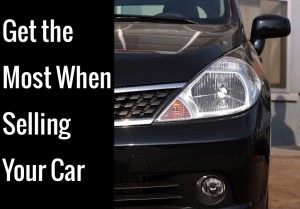 So, you decided to sell your old car and buy a new one. There are some essential subtleties and gimmicks of selling a car which sellers should know to get a fair price. After all, that’s what every seller is after, a good price, whether the car is on sale on the Internet, newspaper or dealership. If you are not careful, you will end up selling your car for next to nothing.
So, you decided to sell your old car and buy a new one. There are some essential subtleties and gimmicks of selling a car which sellers should know to get a fair price. After all, that’s what every seller is after, a good price, whether the car is on sale on the Internet, newspaper or dealership. If you are not careful, you will end up selling your car for next to nothing.
Here is a list of the top 15 ways to get the most cash when selling your car:
1. Get Your Car Cleaned and Waxed
This may sound obvious, but you would be surprised how many sellers overlook this essential part. The logic is simple: people like to buy clean, shiny and neat things, including cars. Your sales ad will likely show a picture of the car, so it is best that the car looks clean and waxed.
You shouldn’t actually go overboard with this, a simple shampooing and waxing is enough for most cars. Also, don’t forget about the interior.
2. Fix What Needs to be Fixed
Old cars usually have small mechanical glitches and a little bit of work can fix them in no time. Inspect the car for faulty mechanical or engine components. An aging brake or a faulty door lock can be fixed easily and it can boost the price up.
Usually, what you can fix will be cheaper than the amount a buyer thinks it will cost. You want to give the buyer as few things to gripe about as possible since they will try to leverage those faults to get a lower price from you.
3. Don’t Sell it to a Dealer
Dealers are professionals who know how to ask for a lower price, much lower than you thought about. They know how to talk the car down and you will be likely coming home with less money than you hoped for. Keep in mind that this may sound as the most convenient way of selling an old car, but it comes at a cost.
Remember that a car dealer will have to buy the car low enough so that they can resell it at a market price and still pay their overhead, which is their mechanics, sales people and property. They simply can’t give you the best price for your car.
4. Advertise Your Car
Choose the best advertising channels currently available. Use auto websites, social media, message boards, forums or even word of mouth. Make sure your car is everywhere. Thus, you will get a quick sale, but also a good price.
Most people have good luck selling their used car on Craig’s List. Post your ad early on a Saturday morning to get people calling and coming over in the afternoon.
5. Know What the Car is Really Worth
Knowing the market value of the car that you are trying to sell is crucial. Browse the prices for similar cars and know the price range for that certain model to make sure you are asking a fair price. Keep as a factor the model year, mileage, car damage, the interior and minor mechanical flaws.
All in all, understanding your car’s market value is one of the most important aspects when asking for a price. You go into the haggling session armed with information that will help you get the best price for your car.
6. Get the Papers in Order
So, you got your car ready, clean, waxed. It may be ready to get inspected by the first buyer, but the papers must also be in order to secure the deal. Service records, history reports and other paperwork must all be in perfect condition and order. Some buyers may ask about the car’s history, damage or other issues and you must be able to provide proof.
Even though the paperwork can be a daunting task, in the end, good paperwork can fetch you a good price for your old car.
7. List Your Car in a Straightforward and Honest Manner
When writing the ad, be sure to highlight the car in a good way. Take time and write a good ad, with technical specifications and other essential information. Keep the ad simple and attractive and don’t use unnecessary information.
You should list why you’re selling the car to help put the buyer at ease. Maybe you plan to buy another car or just plain need the money. Be honest and it’ll bring more people to see your vehicle.
8. Use Good Photos
Photos attract buyers initially, so make sure you provide the best photos of the car. Include interior photos with good lighting, from different angles.
9. Choose the Best Time for Selling
Buying a car is not taken lightly by people, so you need to know that cars can be sold for a better price during certain periods. Usually, the spring is the best season for car renewal, so try to sell your car during this time. Also, try to avoid the end of the month, because that’s when bills are due and people are usually short on cash.
Do not try to sell your car on a holiday weekend like the Fourth of July. People are busy with family get-togethers and other events and you will have less buyers (or maybe none at all) looking at your vehicle. It’s a holiday – go have fun.
10. Always Provide Good Proof of Condition
Try to get a pre purchase inspection from a third party to increase trust between you and a potential buyer. These inspections are usually cheap and can boost the price of the car, and also speed up the transaction.
A local, auto repair shop will do this for you, no problem. If some things are wrong with the vehicle, you can decide to get them fix or you may opt to pass that repair on to the new owner. It’s up to you but if there is a repair that is needed, be honest and disclose that to the buyer.
11. Be Prepared to Show Your Car
A buyer may want to see the car anytime of the day, so you must be sure to have the car in top shape whenever the need arises. Don’t keep the car in dark garage with boxes piled up on it, or else you will leave a bad impression on the buyer. If it’s outside, then make sure it’s clean and not dusty or dirty. If you have a car cover, then use it – it will show the buyer that the car was cared for.
12. Don’t Stop the Transaction Simply Because You Don’t Like the Buyer
This is something that many sellers do without acknowledging it. Keep in mind that you are selling a car to the buyer that offers the highest price. At the end of the day, this is all that matters – getting the most cash out of your old car, not establishing a lifelong friendship with the buyer.
13. Negotiate the Best Price
After a potential buyer offers you a price, the game of negotiation begins. This can be uncomfortable for most people, but you need to know the basics. Establish price thresholds, options and prepare arguments. In the end, if you are not fully pleased, you can use the “Take it or leave it” phrase. It works wonders.
14. Avoid and Handle Complications
Buyers can become uncomfortable with some cars if they require repair work and some unknown flaws can bring the price lower. This is where arguments can arise between the buyer and the seller. Deal with them with calmness and prepare good arguments to support your case. If you are not pleased, cancel the transaction.
It’s better for you if you are in the situation where you don’t absolutely have to sell the car. If you’re desperate, then it’ll show and you’ll be telling the buyer that you’ll accept a low price. Maybe that is what you have to do but if at all possible, for yourself, put yourself in the position where you don’t absolutely need the money right away.
 15. Finalizing the Sale
15. Finalizing the Sale
Getting a good price for your car also involves knowing the laws concerning cars and vehicles in your area. Try to limit your liability in front of a buyer in case anything goes wrong. After you received the money from the buyer, make sure to record the odometer reading and sign the papers. Check with the local authorities the other papers needed for a complete transaction. Remember to contact your insurer about the sale. This final step, if done correctly, will save you a lot of hassle and cash in case some legal issues appear in the future.

Conclusion
If you do good prep work on the car, do some good research and are ready for the sale, then you are more likely to get the most cash when selling your car by yourself. We hope these tips have helped you.
Please pass this article on to others, share it and let us know if you have any thoughts or comments about it.
